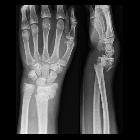Essex-Lopresti fracture-dislocation




Essex-Lopresti fracture-dislocation is characterized by a fracture of the radial head, dislocation of the distal radioulnar joint and rupture of the antebrachial interosseous membrane.
Epidemiology
As little as 20% of Essex-Lopresti fracture-dislocations are recognized at the time of initial presentation .
Clinical presentation
The injury occurs due to the compressive force of trauma transmitted down the forearm through the proximal and distal radioulnar joints and the interosseous membrane . This usually occurs from a fall or high energy trauma with the elbow extended . As a result, there is axial and longitudinal loading that causes pain and instability. The distal radioulnar joint injury may be missed, leading to permanent wrist pain and stiffness or instability. Radiocapitellar impingement due to longitudinal instability may cause lateral elbow pain .
Classification
The proposed classification of Essex-Lopresti fracture-dislocation is based on the severity of radial head fracture .
- type I: large fragments
- type II: comminuted
- type III: chronic injury with proximal migration of the radial head
Pathology
Rupture of the interosseous membrane results in perturbed transmission of force from the radius to the ulna . If not recognized acutely, chronic instability and proximal migration of the radius results in ulna abutment with increased force transmission across the ulnocarpal joint .
Radiographic features
Initial radiographs may be unremarkable for Essex-Lopresti fracture-dislocations .
Treatment and prognosis
There have been historically poor outcomes in the treatment of longitudinal forearm instability which is particularly complex in the chronic setting . The low incidence, late presentations and heterogeneity in study samples presented in the literature preclude researchers reaching safe conclusions and planning of clinical studies . A recent study found that radial head replacement with the reconstruction of the interosseous membranes and central band restores radioulnar displacement and ulna forces to near normal .
The proposed treatment may be based on the classification type .
- type I: open reduction and internal fixation
- type II: radial head excision and prosthetic replacement
- type III: radial head replacement and ulnar shortening osteotomy
History and etymology
It is named after Peter Gordon Essex-Lopresti (1916-1951), a trauma surgeon at Birmingham accident hospital, England .
See also
Siehe auch:
- Colles-Fraktur
- Radiusköpfchenfraktur
- Galeazzi-Fraktur
- Frakturen mit Eigennamen
- Chauffeur-Fraktur
- Monteggia-Fraktur
- Barton Fraktur
- distale Radiusfraktur
- Smith-Fraktur
- Membrana interossea
- Membrana interossea antebrachii
- Luxationsfrakturen von Radius und Ulna
und weiter:

 Assoziationen und Differentialdiagnosen zu Essex-Lopresti fracture:
Assoziationen und Differentialdiagnosen zu Essex-Lopresti fracture:








